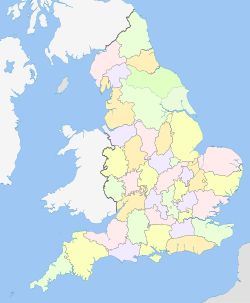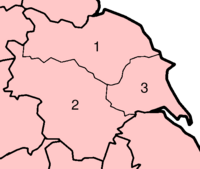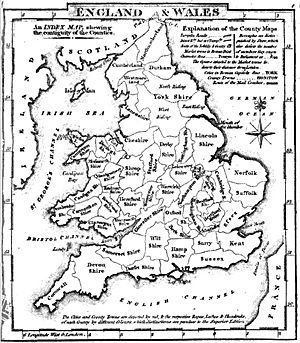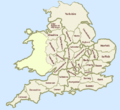Historic counties of England facts for kids
Quick facts for kids County |
|
|---|---|
| Also known as: Shire |
|

Counties of England in 1851 with major rivers, the ridings of Yorkshire, and the remaining exclaves shown
|
|
| Category | County |
| Location | England |
| Found in | Kingdom |
| Created | 5th–11th century |
| Number | 39 (as of 1 April 1889) |
| Possible status | County palatine |
| Populations | c. 21,000—3.4 million (1881) |
| Areas | c. 94,000–3.8 million acres (15,000 km2) (1881) |
| Government | Shire court Shire-reeve (until 1066) Ealdorman Earl (from 1066) Quarter sessions (16th century–1889) County council (from 1 April 1889) |
| Subdivisions | Division, riding, rape, lathe, parts Hundred and equivalent Parish |
The historic counties of England are old areas of land. They were set up a long time ago for managing different parts of England. Many of these areas were based on even older kingdoms and shires created by groups like the Angles and Saxons.
These historic counties are also called ancient counties or traditional counties. For hundreds of years, they helped people feel connected to their local area. Even when new ways of managing local areas were created in 1889, these old counties still mattered. They still form the basis for many modern local government areas today.
Counties were different from towns, which often governed themselves. Counties helped the king or queen control local areas. They did this through people like sheriffs and lord-lieutenants. These officials made sure laws were followed, collected taxes, and organized the military. Later, counties also helped with local government and choosing people for parliament.
Contents
What's in a County Name?
The name of a county often tells you how it was formed. Some counties are named after a main town, like Yorkshire. The word "shire" means a division of land. So, Yorkshire means the "shire" around the town of York.
Other counties were once ancient kingdoms. For example, Kent was a kingdom of the Jutes. That's why it's not called "Kentshire." Counties ending in "-sex" like Essex and Sussex were also old Saxon kingdoms. Their names often point to directions, like "East Saxons" for Essex.
Some county names come from the tribes who lived there. Cornwall and Devon are examples of this. County Durham is a bit different. It was once a special area ruled by the Bishop of Durham, not a town or a kingdom.
Many counties have short, common nicknames. For example, Berkshire is often called "Berks," and Buckinghamshire is "Bucks." Some abbreviations are less obvious, like "Salop" for Shropshire or "Oxon" for Oxfordshire.
A Look Back: How Counties Began
Early Beginnings of Counties
Long ago, the Romans divided Britain into administrative areas. After the Romans left around 410 AD, these divisions mostly disappeared. But in some areas, small kingdoms like Kent started to form.
In southern England, areas called shires grew out of older kingdoms. This happened as the Kingdom of Wessex grew stronger. By the time the Normans conquered England in 1066, the whole country was divided into shires. These shires were managed by a sheriff, who worked for the king. After the Norman Conquest, shires became known as "counties." This meant they were areas under the control of a "count," like in France.
Some counties were formed much later, even up to the 16th century. Because they started in different ways, the counties varied a lot in size. Their borders stayed mostly the same between the 1500s and 1888. Each shire was responsible for collecting taxes, defending its area, and making sure justice was served.
Counties in Southern England
In the south, many counties were parts of the Kingdom of Wessex. Kent comes from the Kingdom of Kent. Essex, Sussex, and Middlesex were named after the East, South, and Middle Saxons. Norfolk and Suffolk were for the "North Folk" and "South Folk" of the Kingdom of East Anglia.
Hampshire is named after an old town called "Hamwic," which is now part of Southampton. Dorset and Somerset get their names from the people who lived around Dorchester and Somerton. Devon and Cornwall were named after ancient Celtic tribes.
Counties in the Midlands
When Wessex took over Mercia in the 900s, it divided the land into shires. These shires were usually named after their main town, like Northamptonshire and Warwickshire. Sometimes the names changed a bit over time, like Cheshire, which was once "Chestershire."
In the east Midlands, county borders might show how the land was divided by Danish armies in the 800s. Rutland was a very small area that eventually became known as the smallest county. Lincolnshire was once the Kingdom of Lindsey.
Counties in Northern England
Many areas in the north were also divided into shires. However, the Normans didn't use these divisions. The large county of Yorkshire was once the Viking Kingdom of York. In 1086, it included parts of what would become Lancashire, Cumberland, and Westmorland.
Counties like Cumberland, Westmorland, Lancashire, County Durham, and Northumberland were created in the 1100s. Lancashire was officially formed in 1182.
Special City Counties
Over time, some large cities and towns were given special status. They became like their own counties, separate from the areas around them. These were called "counties corporate."
For example, Bristol became its own county in 1373. This was because it was a big port city that sat on the border of Gloucestershire and Somerset. Other cities like Norwich, Southampton, and York also became counties of themselves. This special status meant they had more control over their own affairs.
Parts That Were Separated
The old counties had some strange parts. Sometimes, a piece of land belonged to one county but was completely surrounded by another. These were called "exclaves."
In 1844, a law was passed to fix many of these odd borders. For example, parts of County Durham that were surrounded by Northumberland became part of Northumberland. However, some exclaves remained, like the town of Dudley, which was part of Worcestershire but surrounded by Staffordshire.
Changes in the Late 1800s
In 1889, new "administrative counties" were created. These were for local government and had their own councils. Some historic divisions, like the different parts of Yorkshire and Lincolnshire, also became administrative counties.
The new system tried to make sure that towns were fully within one county. For example, if a city like Birmingham grew into a neighboring county, that new area would become part of Birmingham's county.
Big Changes in 1965 and 1974
On April 1, 1965, Greater London was created. This meant the old administrative counties of London and Middlesex were abolished. Other counties were merged, like Cambridgeshire and Isle of Ely.
In 1974, a huge change happened. New "metropolitan" and "non-metropolitan" counties were formed. Some old counties, like Cumberland and Worcestershire, disappeared from the official map. New ones like Avon and Cumbria appeared.
These changes often tried to put large urban areas into a single county. For example, Greater Manchester was created from parts of Cheshire, Lancashire, and Yorkshire.
Counties Today: Still Important?
Even with all the changes, the historic counties are still important in many ways.
For example, county cricket teams are still based on the historic counties. So, you'll find teams like Yorkshire County Cricket Club.
In the 1990s, some historic counties like Herefordshire and Rutland were brought back as administrative areas. Groups like the Association of British Counties work to promote the idea that the old counties still exist with their original borders.
In 2013, the government officially recognized England's 39 historic counties. They even made it easier for traditional county names to be shown on road signs. This helps people remember and celebrate the long history of these areas. Many historic counties now have a special "county day" to celebrate their culture and history.
What Did Counties Do?
By the Middle Ages, counties were used for many important tasks.
Justice and Law Enforcement
Counties were key for the justice system. Judges held courts in each county. People called justices of the peace were appointed in each county to help keep order. They also looked after county prisons.
Later, in the 1800s, county police forces were created. This helped keep people safe as the population grew and moved around more.
Defense and Military
From the 1540s, a person called the Lord Lieutenant was in charge of the military in each county. They were responsible for raising and organizing local soldiers. Later, their role became more ceremonial. The British Army also linked its recruiting areas to the counties.
Parliamentary Representation
Each English county sent two representatives, called "Knights of the Shire," to the House of Commons. This was part of the country's parliament. Over time, the number of representatives changed, and counties were divided into smaller areas for elections.
Local Government
From the 1500s, justices of the peace in each county took on more administrative jobs. They met four times a year to handle "county business." This included things like licensing pubs, building bridges, and managing prisons. They also collected local taxes to pay for these services.
By the late 1800s, people realized it would be better to have more services managed across the whole county.
How Counties Were Divided
Some of the larger counties had their own major subdivisions.

The biggest example is Yorkshire, which was divided into three "ridings": the East, West, and North Ridings. These were so important that they became well-known geographical terms. Lincolnshire was also divided into three "parts." Sussex and Suffolk were informally divided into East and West sections.
Some counties had special areas called "liberties" or "sokes" that were managed separately. For example, Cambridgeshire had the Isle of Ely.
Most English counties were divided into smaller areas called "hundreds." In some northern counties, these were called "wapentakes" or "wards." These hundreds were then divided into parishes, which are still used today for some local services.
List of Historic Counties
The ancient counties, even with changed borders, still form many of the modern ceremonial counties in England. Some old county names are still used in modern counties, like Yorkshire in North Yorkshire. Others, like Huntingdonshire, are now just districts.
Here is a list of the historic counties as they were in the 1800s:
| County | Alternative names | Abbreviation | Additional status | Area rank in 1891 | Ceremonial status (2010) |
|---|---|---|---|---|---|
| County of Bedford | Beds | 36 | extant | ||
| County of Berks | Berks | royal county | 34 | extant | |
| County of Buckingham | Bucks | 33 | extant | ||
| County of Cambridge | Cambs | 25 | extant | ||
| County of Chester | Ches | county palatine | 20 | extant | |
| Corn | Duchy of Cornwall enjoyed some palatine powers | 15 | extant | ||
| Cumb | 11 | disestablished 1974 | |||
| County of Derby | Derbys | 19 | extant | ||
| Devonshire | 3 | extant | |||
| Dorsetshire | Dor | 23 | extant | ||
| County of Durham, County Durham | Co Dur | county palatine | 21 | extant | |
| 10 | extant | ||||
| County of Gloucester | Glos | 17 | extant | ||
| County of Southampton, Southamptonshire | Hants | 8 | extant | ||
| County of Hereford | Here | 27 | disestablished 1974, revived 1998 | ||
| County of Hertford | Herts | 35 | extant | ||
| County of Huntingdon | Hunts | 37 | disestablished 1965 | ||
| 9 | extant | ||||
| County of Lancaster | Lancs | county palatine | 6 | extant | |
| County of Leicester | Leics | 28 | extant | ||
| County of Lincoln | Lincs | 2 | extant | ||
| Mx, Middx, Mddx | 38 | disestablished 1965 | |||
| Norf | 4 | extant | |||
| County of Northampton | Northants | 22 | extant | ||
| Northumb, Northd | 5 | extant | |||
| County of Nottingham | Notts | 26 | extant | ||
| County of Oxford | Oxon | 31 | extant | ||
| Rutlandshire | Rut | 39 | disestablished 1974, revived 1997 | ||
| County of Salop | Shrops, Salop | 16 | extant | ||
| Somersetshire | Som | 7 | extant | ||
| County of Stafford | Staffs Staf | 18 | extant | ||
| Suff | 12 | extant | |||
| Sy | 30 | extant | |||
| Sx, Ssx | 13 | disestablished 1974 | |||
| County of Warwick | Warks, War, Warw | 24 | extant | ||
| Westm | 29 | disestablished 1974 | |||
| County of Wilts | Wilts | 14 | extant | ||
| County of Worcester | Worcs | 32 | disestablished 1974, revived 1998 | ||
| County of York | Yorks | 1 | disestablished 1974 |
Images for kids
-
The Counties of England as recorded in the Domesday Book
-
Notice on the Corn Exchange, Royal Tunbridge Wells, mentioning the historic county boundary
See also
 In Spanish: Anexo:Condados históricos de Inglaterra para niños
In Spanish: Anexo:Condados históricos de Inglaterra para niños




